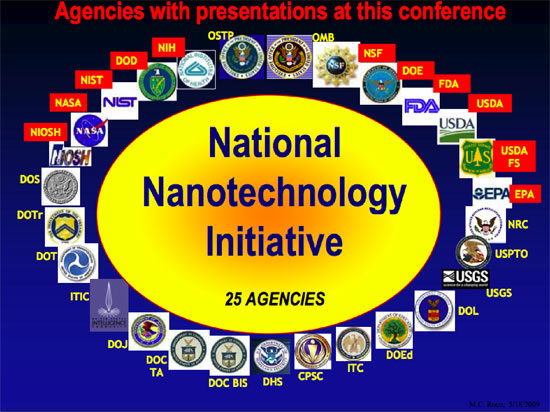While nano may be about things on a very tiny scale – around 10-9 meters, there is nothing small about the government’s investment in nanoscale research -- it’s now around 10+9 dollars.
There were many presentations about the National Nanotechnology Initiative (NNI), at the fifth annual International Nanotechnology Conference on Communication and Cooperation (INC5) in Los Angeles on May 18-21. I got to speak for a few minutes about the NISE Net on the first day of this conference, along with leaders of other academic research and education networks that are all funded by the National Science Foundation (NSF) and part of the NNI.
The NNI is the program established in fiscal year 2001 to coordinate Federal nanotechnology research and development. According to Mihail Roco of the NSF, there are now 25 U.S. agencies participating in the NNI. Ten of them made presentations at the conference.

Of these the National Science Foundation has the largest budget allocated to nanotechnology. In the 2010 budget request, this is $423 million. The Department of Defense, the Department of Energy, and the National Institutes of Health are next with budgets in the $300’s of millions each. Most of the agencies don’t have special centers or programs for nanotechnology but incorporate nanotech in their existing work.
The National Science Foundation has about 5,000 active projects and 28 large centers and networks. The National Institutes of Health has eight Centers for Cancer Nanotechnology Excellence, eight Nanomedicine Development Centers, one Nanotechnology Characterization Laboratory, and four Programs of Excellence in Nanotechnology. The Department of Defense and NASA each have three centers or institutes focused on some aspect of nanotechnology, and the National Institute for Occupational Safety and Health and the National Institute of Standards and Technology each have one. (www.nano.gov/html/centers/nnicenters.html) The Department of Energy has five Nanoscale Research Centers collocated at its five national laboratories and is just now establishing 46 Energy Frontier Research Centers involving 110 institutions from 36 states (www.er.doe.gov/bes/EFRC.html).

At INC5 only the NSF spoke about public and K-12 education programs. Through the NISE Net, science museums are connecting with NSF Nanoscale Science and Engineering Centers and the Materials Research Science and Engineering Centers. But there are many other centers and research projects we can connect with. Some have already participated in NanoDays. Check out the locations of these other centers and institutions on the nano.gov page cited above to see which ones may be in your neighborhood or geographic region.
